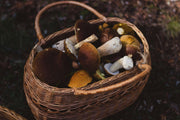Guidance
Are Magic Mushrooms Addictive?
5 min read
Magic mushrooms have long intrigued curious minds for their potential to unlock altered states of consciousness and boost creativity. For enthusiasts and newbies alike, a common question arises: Do magic mushrooms go bad? The short answer is yes, like any natural product, magic mushrooms can lose their effectiveness over time. The rate and extent of spoilage depend on storage methods, mushroom type, and environmental factors.
In this guide, we’ll explore what causes mushrooms to go bad, how to store them properly, and why this matters for microdosing enthusiasts. Whether you're a novice curious about "What is microdosing?" or seasoned in "Microdosing 101," knowing how to care for your mushrooms ensures both safety and efficacy.

Magic mushrooms, like all fungi, are prone to spoilage because of their natural composition. Here are the main culprits behind their degradation:
Moisture
Fresh mushrooms contain high water content, making them an ideal breeding ground for bacteria and mold. Over time, moisture trapped in or around the mushrooms can lead to decomposing.
Temperature
Heat accelerates the breakdown of psilocybin, the compound responsible for their effects. High temperatures can also encourage mold growth and compromise their potency.
Light Exposure
Prolonged exposure to light, particularly UV light, can degrade psilocybin and psilocin, the active components in magic mushrooms.
Air Exposure
Oxygen can cause mushrooms to oxidize, leading to changes in color, taste, and potency.
Beyond physically spoiling, magic mushrooms can lose their potency over time, even if they don’t appear rotten. This is because the primary psychoactive compound degrades when exposed to environmental factors like heat, light, and oxygen. When this occurs, they lose potency and their overall effectiveness decreases.
Even dried mushrooms, which are more stable than fresh ones, can lose their strength if stored improperly. This slow decline in strength means that older mushrooms may need higher doses for the same effects. This can be a problem for microdosing fans who depend on steady, reliable results.
Keeping your mushrooms safe from these harmful factors is as important as stopping visible spoilage. This helps ensure both safety and effectiveness.

Before diving into Microdosing 101, you need to ensure your mushrooms are safe to consume. Here are telltale signs that your magic mushrooms have gone bad:

The shelf life of magic mushrooms varies depending on how they’re stored:
Fresh Mushrooms
Fresh magic mushrooms typically last 7–10 days when refrigerated. The high moisture content makes them susceptible to mold and decay, so you should consume or process them quickly.
Dried Mushrooms
Properly dried mushrooms last significantly longer—up to a year or more. Removing water content prevents bacteria and mold growth, making them more shelf-stable.
Powdered Mushrooms
Ground mushrooms, often used in microdosing, are less susceptible to spoilage but may lose potency over time. Proper storage is crucial to maintaining their efficacy.
Capsules or Extracts
Capsules or liquid extracts of mushrooms can last longer if stored in a cool, dark place. Always check for expiration dates on commercial products. We suggest you use our OOMA microdose capsules within 6 months to a year.

Proper storage can dramatically extend the life of your magic mushrooms, ensuring safety and potency for your microdosing journey.
Drying is the most effective way to preserve magic mushrooms. Use a food dehydrator or place them in a well-ventilated, low-humidity area. The goal is to remove as much water as possible until they snap cleanly when bent.
Store dried mushrooms in an airtight glass jar or vacuum-sealed bag. This prevents exposure to air and reduces the risk of contamination.
Keep your container in a cool, dark place, such as a pantry or cabinet. Avoid exposure to sunlight or heat sources like ovens and radiators.
Adding food-safe desiccant packs to your storage container can absorb residual moisture and extend shelf life.
For long-term storage, consider freezing dried mushrooms. Place them in a vacuum-sealed bag or an airtight container to prevent freezer burn. Frozen mushrooms can remain potent for years when stored correctly.

Microdosing involves taking sub-perceptual doses of magic mushrooms to enhance creativity, focus, and mood. Microdosing means taking small, measured amounts of substances. These amounts do not cause the same effects as a "typical recreation dose" but can offer subtle benefits.
Ensuring the quality of your mushrooms is crucial for several reasons:
Safety
Spoiled mushrooms can cause food poisoning or other health risks. Proper storage minimizes contamination and ensures safety.
Potency
The active ingredient in magic mushrooms degrades over time, especially when exposed to heat, light, or moisture. Proper storage preserves potency, ensuring consistent effects during microdosing.
Consistency
Microdosing requires precise measurement. Using degraded mushrooms with inconsistent psychedel-ish levels can lead to less predictable results.
For those venturing into microdosing, starting with high-quality mushrooms is essential. Here’s a quick guide to get you started:

So, do magic mushrooms go bad? Absolutely. Like any organic material, they’re susceptible to spoilage. However, with proper drying, storage, and handling, you can extend their shelf life and maintain their potency for microdosing.
If you are into microdosing, keeping your mushrooms high quality is important. This ensures a safe and effective experience. Whether you use fresh, dried, or our OOMA capsule, taking care is important. This helps you get the most from your microdosing journey.
Keep your magic mushrooms safe, and let the benefits unfold—one mindful dose at a time.
Check out our ingredient breakdown to learn more about OOMA's recipe and intention.
Taxes and shipping calculated at checkout.
